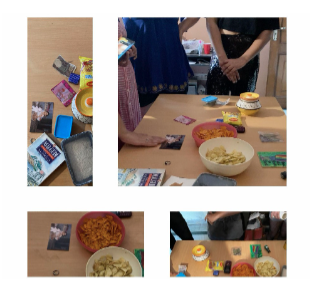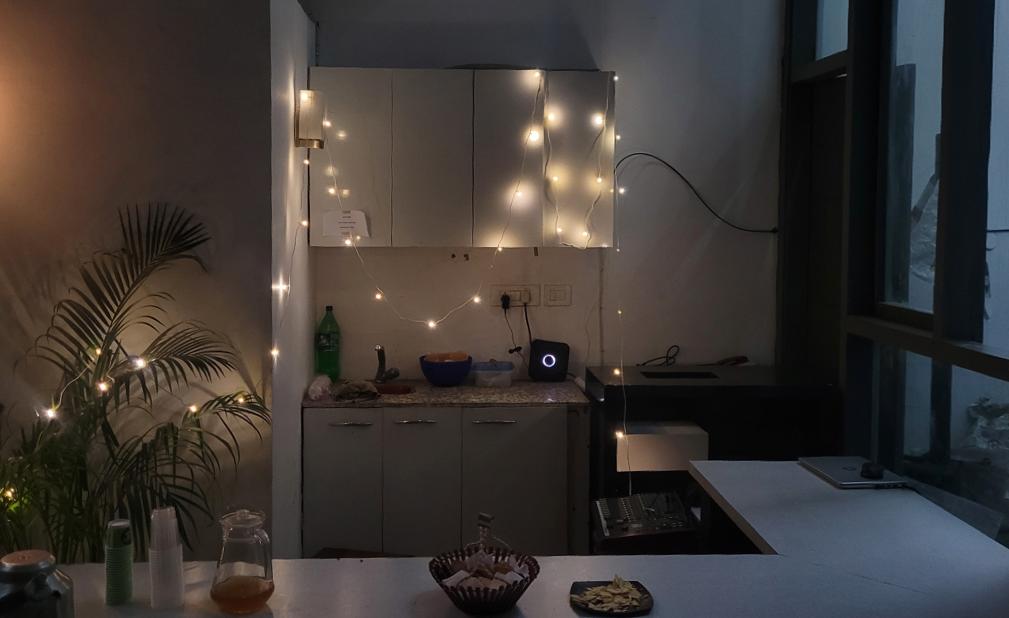Fluid Objects, Fluid Homes
AUTHOR
Manvendra Singh Thakur
How are homes made? Do objects make it? Or, is it the body?
Body > Object > Home > Object > Body > Object > Home > Object > Body > Object > Home >
For many of us queers, homes are often defined by their fleeting-ness. They are never permanent. There is a continuous seeking of home elsewhere, migrating from ‘familial homes’ in search of spaces that might welcome us.
Friends are made in new cities and they fill newfound homes with objects. These objects carry meanings, and in time, new meanings are also given to them.
The performance ‘Let’s Make a Home’ was conceived on similar lines. In its two iterations, it has been performed both intimately and publicly. The first took place at a home as part of my birthday get-together. Friends were invited to bring an object that reminded them of home but was something they were ready to let go of. During the soirée, the guests gathered together and were asked to present the object they brought. Everyone adhered to the invitation’s instructions. The second iteration occurred as part of a performing arts festival, where participants knew the details beforehand.
The space was filled with diverse objects: a small old phone, a childhood photograph, a book, a vessel, a packet of masalas, a box of rice, a cube of cheese, a packet of instant noodles, an old painting, a bottle of analgesic, dried flowers and leaves, a hand-drawn card, and an old one-rupee note.
After everyone had placed their objects on the empty table, they were asked to choose one that was not theirs.
Holding the object of a fellow guest, each person shared how it reminded them of home. The narratives built through the nostalgia of home started filling the space. These objects, part of a slice of memory, made up home for the folks present — objects whose presence is felt even in the absence of their past life. The space became one of intersecting histories of the participants/guests. The narratives linked to the object implicitly elaborated on one’s social location.
The interaction of the object in the past is given a new meaning by the new user. The memory of it remains, while a new memory forms around it. This exchange, heightened by co-presence and shared memories, not only brings different contexts together but also transforms individual memories into shared ones. The object in the performance has an afterlife of its own after the ephemeral exchange. José Esteban Muñoz who was a Cuban American academic in the fields of performance studies as well as queer theory employs ephemera as alternate modes of textuality and narrativity like memory and performance. He is interested in looking at the traces left after the performance, the “traces, glimmers, residues and specks of things” [1].
The residue of a performance may often convey more than the performance itself.

As the participants collected their thoughts and listened to each other, the evening brought with it a palpable sense of togetherness, even if ephemeral, the act of sharing engendering a shared sense of belongingness.
The performance action ‘Let’s Make a Home’ seeks to highlight a move beyond heteronormative inheritances and engages with queer modes of sharing and making homes.

Many at the get-together were meeting each other for the first time. An action built on the exchange of objects can lead to the possibility of solidarities of some kind. For someone who is always changing homes, moving to new cities, towards new futures, objects can often make a place feel like home. These objects could be material or immaterial but are necessary elements for the meaning-making of homes. These objects may also be looked at as choses en mouvement (“agents”)[2]. In a queer imagination, objects are often difficult to describe in terms of their culture and social contexts because of their moving and transitory nature. A connection can be made through intentions as a liaison between objects and context. Since objects are not in isolation, they are often in conjunction with other objects and often in a whole space.[3] The objects gathered through the performance hold different meanings for each person present, but their conjunctions with other objects framed through the idea of home open a possibility of meaning-making and different provocations.
The performance explores the production of performative space which is both personal and communal allowing a possibility of juxtaposing diverse histories and social positions. However, the act of curating such a space raises important questions: Who feels comfortable enough to share? Who is present, and who is missing?
In the initial iteration of the performance, it was set within the intimate confines of the artist’s home. This setting could naturally bring in a sense of closeness and familiarity among participants, who were primarily friends and acquaintances. The domestic environment, a private and personal space, encouraged an openness that might not be as easily achieved in a more public setting. Here, the act of sharing objects imbued with personal significance was supported by the comfort of being among known individuals, within a space that was already charged with personal memories and meanings. However, this also raises important questions about who is invited into such a personal space and who remains excluded. The decision to hold the performance at home inherently involved choices about inclusion and exclusion, as the guest list was necessarily limited by the physical space and the personal nature of the gathering.
When the performance was later translated to a public festival space, the dynamics shifted. Festivals, by their nature, are designed to attract broader audiences, offering a platform for diverse artistic expressions. However, they also bring with them new layers of complexity, particularly around the concepts of public and private. The festival setting—a more public, structured environment—invited a wider audience to engage with the performance. Yet, this broader access came with its own set of challenges. Festivals are often ticketed events, and this barrier can be exclusionary, limiting participation to those who can afford entry or are aware of such cultural events. The transition from a private home to a ticketed festival space introduces the potential for exclusion such as socio-economic factors, making the performance accessible to some while potentially excluding others.
The performance, in both settings, invites reflection on the filters—such as cultural background, social class, and familiarity with performance art—that determine who feels welcomed or able to participate. The performance sets out to explore the creation of a communal home but at the same time also challenges participants and observers to consider how the boundaries of inclusion and exclusion are drawn within any community, even in spaces imagined to be open and welcoming.
The site became a place to look at objects as a part of home-making practice. As Blunt and Dowling underline, these practices become a medium by which dwellers ground personal and social meanings in the new residence, turning it from a house into their home.[4] It became a space where objects might not be prized for their market value but for the associations, affective, and emotional geographies they produce. As Stiles traces, the importance of such objects lies in containing traces of the history of past action (life) through the present and with a view to the future.[5] This performative space highlights the overlapping and collaborative project that may be a ‘queer home’ one gets to take part in it and take someone else’s home to their home. This idea, in some ways, could facilitate newer modes of queer world making through sharing one’s homes, giving them further mobility, and presenting what it means for queer folks to make a place home in worlds that are least welcoming and heteronormatively coded.
An ephemeral space becomes conducive to sharing through friendship and intimacies towards a world desired. To not just think of what and how queer homes are made but what queering of homes entails—a tapestry of possibilities of finding homes.
Home is performatively polyvalent. The ‘doing’ of home is like a performance. In its repetitions, there will be mutations. There will be traces and impressions of it left. It is in the here and now as much as it is in the memory of it.
References
Appadurai, Arjun. 2013. The Social Life of Things: Commodities in Cultural Perspective. Cambridge: Cambridge University Press.
Arcidiacono, Francesco, and Clotilde Pontecorvo. 2019. Home Spaces and Social Practices.
Blunt, Alison, and Robyn Dowling. 2006. Home. New York: Routledge.
Muñoz, José Esteban. 1996. “Ephemera as Evidence: Introductory Notes to Queer Acts.
Stiles, Kristine. 2012. Theories and Documents of Contemporary Art: A Sourcebook of Artists’ Writings. Berkeley: University of California Press.
Notes
[1] José Esteban Muñoz, “Ephemera as Evidence: Introductory Notes to Queer Acts,” Women & Performance: A Journal of Feminist Theory 8, no. 2 (1996): 5-16, 10.
[2] Arjun Appadurai, The Social Life of Things: Commodities in Cultural Perspective (Cambridge: Cambridge University Press, 2013), 17.
[3] Francesco Arcidiacono and Clotilde Pontecorvo, Home Spaces and Social Practices (2019).
[4] Alison Blunt and Robyn Dowling, Home (London: Routledge, 2006).
[5] Kristine Stiles, Theories and Documents of Contemporary Art: A Sourcebook of Artists’ Writings (Berkeley: University of California Press, 2012).
About the Author
Manvendra is an artist with an expansive background and keen interest in Performance Studies. Their work explores the intersections of performance, identity, and social inquiry, with a particular emphasis on the concepts of home and belonging. Passionate about digital and everyday performances, Manvendra creates both virtual and real time performance art pieces that serve as platforms for imagining an alternative. Deeply inspired by the vibrant landscape of Delhi, which they consider their first love, Manvendra’s work is driven by an enduring curiosity about the transformative potential of performance art.

